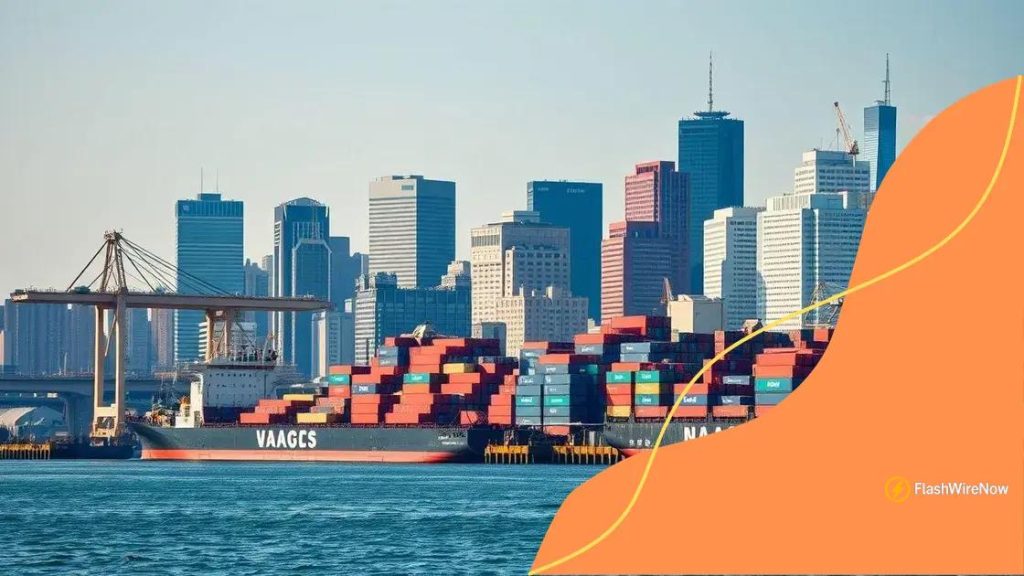Trade war impacts on US businesses: what’s at stake?

Anúncios
Trade war impacts on US businesses include increased consumer prices, reduced product availability, and the necessity for companies to adapt through supply chain diversification and innovation.
Trade war impacts on US businesses pose significant challenges and opportunities in today’s economic landscape. Have you wondered how these conflicts affect prices and innovation? Let’s dive in.
Anúncios
Understanding the trade war dynamics
Understanding the trade war dynamics is crucial for grasping how recent policies affect the economy. These conflicts often arise from disputes over tariffs, trade balances, and regulations. As countries impose tariffs on each other’s goods, the repercussions can ripple through various sectors.
Key Terms to Know
Before diving deeper, it’s essential to familiarize yourself with some key terms that impact trade wars:
- Tariffs: Taxes imposed on imported goods.
- Trade Deficit: When a country imports more than it exports.
- Protectionism: Policies aimed at protecting domestic industries.
As countries retaliate against tariffs, businesses face a complex landscape. For instance, U.S. manufacturers may see increased costs for raw materials sourced from affected countries. This could lead to higher prices for consumers, affecting overall economic growth.
Anúncios
Global Impact
The dynamics of a trade war extend beyond borders. Global supply chains are interconnected, meaning disruptions in one country can impact others. For example, a rise in tariffs can lead to reduced exports for American farmers, while consumers might struggle with higher prices for goods.
Furthermore, businesses need to adapt quickly to these changes. Many are reevaluating their supply chains and looking for alternatives to mitigate risks. This adaptability is vital for maintaining competitiveness in a shifting market environment.
Ultimately, understanding how these trade war dynamics unfold can provide insights into future economic trends. It’s not just about immediate costs; the long-term effects can reshape entire industries and consumer behavior.
Key sectors affected by trade policies
Key sectors affected by trade policies include various industries that play significant roles in the U.S. economy. Understanding how these sectors respond to trade changes is essential for businesses and consumers alike.
Agriculture
The agricultural sector is one of the most visible areas impacted by trade policies. U.S. farmers often rely on exports to drive profits. When tariffs are imposed, it can lead to reduced sales overseas.
- Export Challenges: Higher tariffs can make U.S. products less competitive globally.
- Price Fluctuations: Tariffs can lead to sudden price changes for commodities.
- Market Access: Farmers might lose access to key markets.
Beyond agriculture, the manufacturing industry also feels the heat from trade policies. As tariffs increase on imported goods, manufacturing costs rise. This can lead to higher prices for consumers and reduced profit margins for manufacturers.
Technology
The technology sector faces unique challenges as well. Many tech companies depend on global supply chains to keep production costs low. When trade tensions rise, companies may find themselves facing delays and increased costs for essential components.
Moreover, the automotive industry must adapt to these changes quickly. Tariffs on imported parts can lead to increased vehicle prices, affecting consumer choices. Manufacturers may also need to reconsider where they produce their vehicles.
Ultimately, these key sectors show that the effects of trade policies are far-reaching. With interconnected global markets, changes in one area can lead to consequences in others. Understanding how these sectors react helps predict future economic trends.
How US businesses can adapt

How US businesses can adapt to the changing landscape brought by trade wars is essential for survival and growth. Companies are exploring various strategies to stay competitive in a challenging market.
Diversifying Supply Chains
One effective method is diversifying supply chains. By sourcing materials and components from various countries, businesses can minimize risks associated with tariffs and disruptions. This strategy helps reduce dependency on any single country.
- Cost Management: Companies can find more affordable suppliers to offset increased costs.
- Flexibility: A diverse supply chain allows for quicker responses to changes in trade policy.
- Risk Reduction: Spreading suppliers across different regions lowers the impact of localized disruptions.
Another way US businesses can adapt is through innovation. Investing in new technologies can help streamline operations. Automation and artificial intelligence are great examples. These technologies increase efficiency and reduce labor costs, making companies more competitive.
Customer Engagement
Understanding the ever-changing needs of customers is vital. Businesses should focus on building strong relationships with their clients. Enhanced customer engagement can help companies tailor their products and services to meet specific demands.
Furthermore, staying informed about market trends is crucial. Regularly conducting market research helps businesses anticipate changes and adjust their strategies accordingly. This proactive approach ensures they remain relevant in a fluctuating economy.
In conclusion, adapting to trade war dynamics requires a multi-faceted approach. By diversifying supply chains, embracing innovation, and engaging with customers, US businesses can navigate these challenges successfully.
Economic consequences for consumers
The economic consequences for consumers resulting from trade wars are significant and can be felt in various aspects of daily life. When tariffs are imposed on imports, prices often rise, affecting what consumers pay at the checkout.
Price Increases
One of the most immediate effects of trade policies is the increase in prices for consumer goods. For example, when tariffs are added to foreign products, companies may pass those costs onto customers. This leads to higher prices on everyday items such as electronics, clothing, and food.
- Higher Costs: Imported goods can become more expensive.
- Reduced Choices: Some products may disappear from the market.
- Impact on Budget: Families may need to adjust their budgets to accommodate these changes.
The impact is not just limited to prices. Trade wars can also lead to economic uncertainty. Consumers may feel anxious about job security if companies begin to cut back on production or jobs in response to higher costs. This uncertainty can affect spending habits, leading to decreased consumer confidence.
Quality of Goods
In addition to price increases, the quality of available goods can also change. Domestic companies may not face the same competition as before, potentially resulting in lower quality products. Without international competition, there is less incentive for companies to innovate or maintain high standards.
Moreover, households may experience a shift in their purchasing behavior. As prices rise and choices diminish, consumers might become more cautious. They may prioritize essential items and reduce spending on non-essential goods, further impacting the economy. Understanding these economic consequences helps consumers navigate the changing landscape.
Future outlook of trade relations
The future outlook of trade relations is a topic filled with uncertainty and potential. As countries navigate the complexities of global commerce, changes in policies, economies, and technologies can significantly shape these relationships.
Emerging Trends
One emerging trend is the shift toward regional trade agreements. Countries may seek to strengthen ties with nearby nations rather than relying solely on global trade networks. This can help them avoid some of the tensions associated with larger trade wars.
- Increased Cooperation: Countries are likely to work together more closely on trade issues.
- Focus on Sustainability: New agreements might prioritize sustainable practices and environmental concerns.
- Technological Adaptation: Businesses will adapt to trends like digitization and e-commerce.
Another important factor is the role of technology. Advancements in logistics and communication will play a key role in shaping how trade relations develop. As businesses adopt new technologies, they will be able to operate more efficiently, potentially lowering costs and improving service.
Political Factors
Political decisions will also influence trade relations. Changes in leadership or government policies can lead to shifts in trade agreements and tariffs. For example, elections in major economies can bring new trade strategies that impact global markets.
As countries engage in negotiations, they will need to consider the balance between protecting domestic industries and fostering international trade. Striking this balance is crucial for sustainable economic growth and maintaining positive trade relationships.
The future of trade relations holds the promise of greater collaboration, yet challenges remain. By understanding these dynamics, countries can position themselves to thrive in an evolving global economy.
FAQ – Frequently Asked Questions about Trade Wars and Their Impact on Businesses
How do trade wars affect consumer prices?
Trade wars typically lead to higher tariffs on imported goods, which increases prices for consumers on everyday items.
What strategies can businesses use to adapt to trade wars?
Businesses can diversify their supply chains, invest in technology, and strengthen customer relationships to better navigate trade challenges.
Will trade wars impact the availability of products?
Yes, trade wars can lead to a reduced selection of products as companies may limit imports to manage costs.
What is the future outlook for global trade relations?
The future may see stronger regional trade agreements and an emphasis on cooperation, which could lead to improved trade relations.





